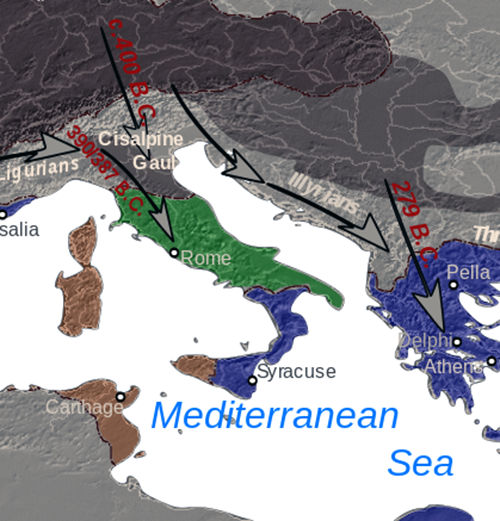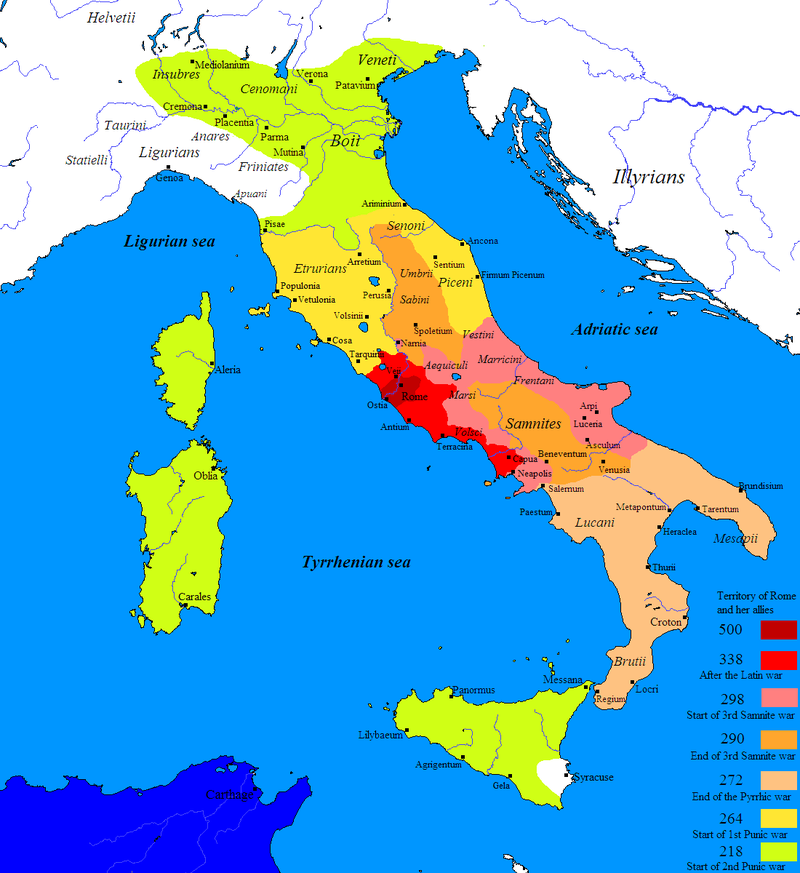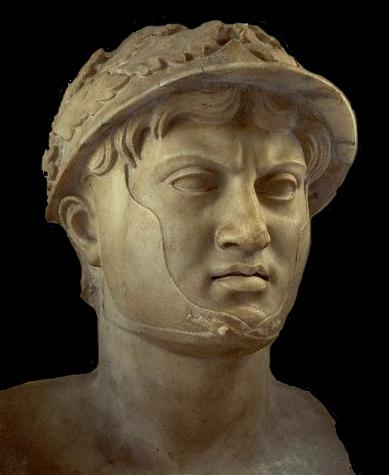The battle of Roman Republic against the Etruscans
Contrary to the tradition of Rome, after the expulsion of Tarquinians and Etruscans and with persistent struggle with them that followed, it all led to the strengthening of neighbouring Latin cities. Especially was tough fight with the king Porsena of Etruscan town Clusium. He besieged the city, demolished the walls and made peace under unfavourable conditions for Rome. However, the Etruscans did not succeed to re-fortify on the left bank of the river Tiber because they encountered resistance from Latins, which had help from Greeks, Cumae.
A number of Roman legends were associated with this period – Horatius Cocles, Mucius Scaevola who was in captivity since he failed to kill Lars Porsena (etruscans king), he promised himself that he would put his hand in the fire without a voice of crying before he would betray.
This fact impressed Porsena, and it led him to make honourable peace. Cloelia, together with other girls that were in captivity decided to swim with them river Tiber – Romans erected a statue of her on horseback – and those legends have an etiological character (Scaevola – “left handed” …)
Rome and the Latin cities
In 496 BC, according to tradition the victory of Romans over Latins near the Lake Regillus – was unlikely to happen, because the victory could only be partial. In 493 BC, Consul Spurius Cassius – made an alliance with the Federation of Latin cities. That was how the Romans fought in the Federation army under the command of the Latin dictators. Therefore, they quickly defeated tribes Aequi and Volsci.
A Gauls invasion of Roman Republic



Shortly after 396 BC, Central Italy was under invasion Gauls (also Celtic tribes). During the last decades of the fifth century, Celtic tribes crossed the Alps and settled in the valley of the river Po. In 390 BC or 387 BC, Celtic tribe – Senones crossed the Apennines, invaded Central Italy and besieged Etruscan city Clusium. The residents of the city asked for help from Rome. Romans sent deputies, which did not limit themselves only on negotiations, but they engaged in a fight – Gauls campaign against Rome. Romans have been defeated at the river Allia, a tributary of the river Tiber. Gauls occupied and robbed the Rome. The only part that remained was the Capitol (legend: defenders awakened Juno geese just before an unexpected attack of Gauls). After the ransom was paid, the Celts retreated (their villages were threatened by tribes from the Alps), but the tradition associated this with Camillus which was an unnamed dictator. He built Rome again.
The consequences of wars:
- weakening of the Roman influence in Lazio and temporary termination of the Latin Federation, which at that time became much stronger.
- around Rome solid walls were built which are visible today.
- the Romans were forced to fight with and Aequi,Volsci and Etruscans (from which Romans emerged victorious).
- Risks of new Gallic invasion strengthen federation (alliance) of Latin cities in which Rome participated with equal rights. In the middle of the fourth century, Rome was a powerful city in the province of Lazio.
Roman conquest of Italy and the fight with Pyrrhus
An alliance with Samnites was not permanent (Samnites federation had a larger territory of the Latin). The head of the Latin federation was at that time Rome. This alliance was more centralized than alliance with Samnites, and it was more advanced in economic terms. Conflict was around fertile land of Campania, which both of them wanted. According to tradition, the Samnites threatened Campanians, but they came under the reign of the Romans – which led to First Samnites War – from 343 BC to 341 BC in which Rome achieved victory.
Latin war
In 340 BC, a rebellion of the Latin happened because they wanted the same rights as the Romans. Campanians joined Latins in their quest. In 338 BC, an uprising ended with the victory of the Romans – the Latin federation ceased to exist.
The villages around the Rome became parts of the city (synoecism). Residents of the other Latin cities were given civil rights (ius comercii – trades and acquiring of ownership, some citizens acquired ius conubii – the right to marry Roman citizens) but without the right to vote in the Assembly. Only two cities were regarded as Roman allies: Tibur and Preneste. A foundation of Latin citizenship was laid down.
Samnite Wars
In 327 BC, began the Second Samnite War, which lasted from 327 BC to 304 BC. The occasion for the war was Roman conquest of Neapolis. The beginning of the war was very successful for Rome. On their side came Lucani and Apulians. However, the war for Rome was difficult because of the new conditions of struggle in the mountains of Sabellian tribes.



In 321 BC, Roman army was trapped at the Caudine Forks, they surrendered, and soldiers were forced to pass under a yoke (the most shameful thing for soldier). The consequence of this defeat was that the Romans had to leave all occupied cities and they had to leave 600 hostages until the peace agreement was made. The turning point occurred in 316 BC, when the Romans changed tactics by reorganizing the army. They created less manoeuvrable squads, with short spears and short swords. This brought to the Romans considerable success. Towards the end of a long Samnite war, under Roman rule fallen Hernici and Aequi.
In 299 BC, after a long truce Gauls associated with the Etruscans came to the territory of Rome. Samnites used this and they again established themselves in Lucania, which was the reason for the Third Samnite War 298 to 290 BC.
War operations were conducted in various areas of Italy. A particular danger to the Romans was at the northeast, in Umbria where Gauls, Etruscans and Samnites supposed to join. However, the Romans invaded in Etruria, and the Etruscans left Gauls. The Romans won in this crucial battle at Sentinum in 296 BC. They defeated Samnites and Etruscans.
Romans made peace with Etruria, while Manius Curius Dentatus (homo novus, also a model of Roman modesty) disastrously defeated Samnites. Samnites were forced to enter into alliances with Rome. The territory crossed into Roman hands and cities became part of the state, but with no voting rights (civitates sine suffragio). Picentes from the coasts of Adriatic Sea also surrendered and the Latin colony of Adria was founded at that place. The Romans from that time were masters of the Central Italy.
After the great victory at the Battle of Lake Vadimo in 288 BC, Gauls tribes were rejected in the north, and the Etruscan cities were forced to conclude an alliance with Rome.
Rome and Tarentum
After the victory over the Samnites and conquering the Central Italy, Rome came into direct contact with the Greek cities of southern Italy. At the beginning of the third century, the largest of them all was Tarentum. By violating contract with Tarentum, Romans through the Adriatic coast arrived in their bay. Tarentum people have sunk one part of their fleet, which offended Roman deputies. This was the reason for war.
The war with Pyrrhus



Tarantum invited Pyrrhus from Epirus against Rome, who dreamt of creating a strong country and he willingly accepted the proposal. In 280 BC, he came in Italy with 22.000 infantrymen, 3,000 cavalry and 20 elephants. The same year, near Heraclea happened first battle, and Pyrrhus, among other things thanked to the elephants victory. Lucani and Samnites moved onto his side together with almost all Greek cities. Pyrrhus passed through the Campania and Samnium, and he intruded in Lazio. However, he did not gain support of Latins, and the Romans concentrated considerable forces in Lazio, so he was forced to return to Tarantum.
In 279 BC, Pyrrhus achieved victory in battle of Asculum, but he had so many losses that he sent messengers to Rome with a peace offer that the Senate rejected. Rome at the time made a pact with Carthage. Soon after that, Pyrrhus quarrelled with Tarantum people and he decided to leave Italy. He decided to search for happiness in Sicily, where he conquered almost all Carthaginian possessions. However, he had an idea that at the head of a huge fleet (made by an enormous effort of the Greek cities) he attacked opponents within Africa – Greeks decided to enter in alliance with the Carthaginians. Since the army of Carthage appeared in Sicily, Pyrrhus ingloriously returned to Italy. This made at the first moment the Romans to retreat from their changeable struggles with the local Tarentum people. However, in 285 BC, at Beneventum under the command of Manius Curius Dentatus, Romans made a decisive victory over Pyrrhus and gained a huge trophy. In 272 BC garrison who Pyrrhus left to Tarentum people surrendered to the Romans. Romans had to surrender the fleet and to tear down walls. That same year, under Roman reign have fallen Samnites, Lucani and Brutii, which fought on the side of Pyrrhus.
In 265 BC, Romans occupied the Etruscan town Volsinii and with this occupation, conquest of Italy was completed. Diplomacy and divide et impera (divide and rule) policy has played a major role in Roman success.
